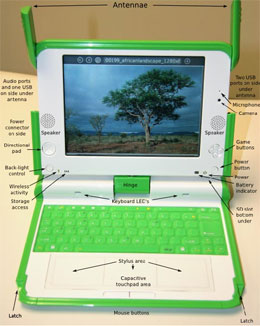Intel joins forces with $100 laptop project for poor children
Intel joins forces with $100 laptop project for poor children
mongabay.com
July 13, 2007
Intel has teamed with the One Laptop Per Child (OLPC) program, agreeing to contribute funding and join the board of the nonprofit group that seeks to bring low-cost laptops to children in poor countries, reports the Associated Press. The announcement comes after Intel chairman Craig Barrett criticized the project in an effort to boost support for its own child-focused Classmate PC.
Microsoft had a similar change of heart last year, with Bill Gates initially skeptical of the rugged computer, then later saying he supported project founder Nicholas Negroponte of the MIT Media Laboratory. Microsoft has said it would soon introduce a $3 version of the Windows operating system for poor countries.

Click to enlarge |
The laptops have been billed as a durable low-cost PC for students in developing countries. The project has received support from Google, AMD, Brightstar, News Corporation, Quanta Computer, and Red Hat. The laptop, which was tested by the U.S. State Department in last November, is WiFi- and cell phone-enabled, and can be powered using a hand-crank. It is designed to be used in harsh environments such as remote rural areas in developing countries. The weather-proof laptops will available in some 30 colors.
So far the governments of Uruguay, Argentina, Brazil, Pakistan, Thailand, Nigeria and Libya have agreed to pay about $175 for each OLPC laptop, though the price is eventually expected to approach its $100 target. Some American computer manufacturers have expressed concern that OLPC laptops could end up in U.S. schools, creating fierce competition in the domestic PC market.
The laptop has faced other criticism, notably from some development experts who say that developing countries should not be asked to foot the bill for what is an unproven technology. Nevertheless the OLPC computer has won acclaim from the U.N. and the U.S. state department.
Intel has launched its own low-cost computing initiative deep in the Amazon rainforest.














